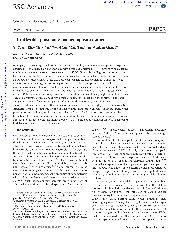摘要
A simple yet efficient approach to fabricate an ultraflexible plasmonic nanocomposite aerogel is described. High-quality gold nanoparticles with a wide size regime (13-101 nm) may be dispersed evenly into a viscous agarose aqueous solution at 60 degrees C. Gradually cooling the solution to room temperature lead to the formation of a nanocomposite hydrogel, which can be further converted into an aerogel by freeze-drying. Using this approach, particle loading as high as 92 nmol L(-1) was achieved without any aggregation or agglomeration for the entire process. The resulting nanocomposite aerogel possesses well-pronounced surface plasmon resonance and exhibits superior mechanical strength yet remains ultraflexible. The maximum Young's modulus was estimated to be about 0.45 MPa in a typical compression test. In addition, an exceptionally high strain of more than 90% was observed, which is about two orders of magnitude larger than most brittle silica-based aerogels (i.e. only a fraction of a percent of strain-to-disintegration). Further structural characterizations demonstrated that the nanocomposite aerogel has a highly porous honeycomb structures, which is responsible for the unusually large strain observed. Only under sufficiently high pressing forces, the honeycomb structures collapse due to plastic deformation, leading to the formation of stiff nanocomposite paper with lamellar structures. This study demonstrates a robust approach to ultralow-density plasmonic aerogels with a myriad of potential applications in aerospace, foldable electronics and portable sensors.
- 出版日期2011
